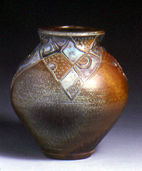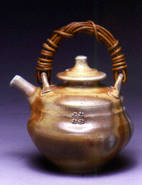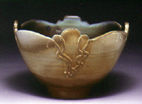Click to find out more...
Show your support by visiting our sponsor...




Jar


Jar


Lidded Jar
In between answering student’s questions, checking on a problematic kiln and preparing for a lobster boat trip, Iowa potter Clary Illian spoke to Forrest Snyder of Critical Ceramics on the deck outside the pot shop at Haystack.
CC: I attended the SOFA exhibition in NYC recently. The crafts and presentation were very sophisticated and refined; arriving at Haystack this morning provides quite a contrast. Would you ever consider doing a show like SOFA?
CI: God, no! First of all, I would never be asked...
CC: One of the things that struck me was that folks were buying $20,000 pieces simply to match the decor in their living rooms.
CI: As you’re saying that, it occurs to me that when people come into my show room, and say things like, “I only have warm tones in my kitchen...”, I’m actually not offended because I have a wide range of shapes and traditional glazes. So, it seems to me, that if they add in another piece within my parameters, it’s really not so terribly offensive. When it comes down to sheer utility, I don’t mind those kinds of demands.
CC: Does that mean you’re willing to create pieces with specific glazes to meet customer’s requests?
CI: It’s not like I’m going to turn around and do exactly what they request, but I might suggest that “a black might look nice or a white porcelain.”
CC: When those folks come in and say here’s what I’m looking for and why, doesn’t that influence you? Several years later, perhaps?
CI: You’ve hit on an interesting area that I’ve never tried to explore. That is the whole market driven, top-down, attempt to get people to buy a whole new group of things because something is “in” that year. No. I would never respond to that.
CC: What if you were determining what was “in” that year?
CI: If I were queen, I would say that my range would never be that narrow because it wouldn’t be market driven. It would be driven on the basis of excellence.
CC: Isn’t part of excellence getting the work out there?
CI: First of all, I think that the people who say they are making utilitarian pots are at the service of utility. As far as the aesthetics of the pots, we are educators. We are not to be led around by our noses. We are the ones who have to take responsibility. And I think it’s entirely doable because the people who buy crafts really like to have personal contact with the maker.
CC: That’s exciting and provides the opportunity for education of the maker and buyer alike, don’t you think?
CI: I find that when customers come to me with a very specific need - say an oil lamp burner or a garlic dish - and nothing else, what they really want to do is feel involved in the creative process. If I were to be candid with them, I’d say, & #147Look. I’ve got bowls of every shape and size. Covered containers of every shape and size. It’s all here!”
CC: So, the customer’s demands do seem offensive?
CI: I try to convey to them that I’m on a passionate quest. Then they get it, “Oh, she’s making utilitarian pots, but it’s a journey. It’s a quest.”
CC: In a sense, by selling them a pot, you’re including them in on a few steps of that journey?
CI: Exactly. I’m saying, “Come along with me.”
CC: Do you have techniques for hooking people without the verbal education?
CI: I think the technique is not even a technique. They must live with one of the pieces for a while. I think we have a great affinity for what is familiar to us.
CC: Given that, do you think there’s a uniformity occurring in potters around the world?
CI: I think what’s happening is that the regional looks are no longer actually regional. That is, they’re no longer geographically based. They are choices makers make. Choices of affinity. They enjoy communities of formal interests.
CC: Is that based on experience?
CI: It’s based on affinity, as I said, and then it’s based on who your teacher was.
CC: In learning, what do you think about copying a teacher’s work versus making one’s own work?
CI: We’ve been talking a lot about this in the workshop. I really like to stress to the students that as they are going through this learning experience that when they borrow, they can borrow the generic underpinnings. They must be careful to discern between these generic underpinnings and all of the little grace notes that comprize style so that when you come to the surface of your pot, don’t make Suze Lindsay’s lines for example. Invent all those grace notes that push personal stylization.
CC: That’s hard...
CI: It’s super hard!
CC: Do you see recognizable signs that a student’s “getting it” and is ready to flip from copying into their own?
CI: One of the bad things about graduate education is that it teaches us all to have really good raps about what we’re doing. It has to start with copying to develop hand-eye skills. Beyond that, the inexperienced maker might say, “Am I going to do Michael Simon fish, today?” Or am I going to ask, “Do I actually have any fish in my life? Well, no. What references do I have that are more central to my own life?” It always feels forced to begin with. You have to do them a while to own them.
CC: Do you need regular contact with your potter peers?
CI: Not so much anymore. I think that heaven is having a discussion with a peer with an interesting mind. Someone like Mary Baringer. Also, coming here, I like seeing what’s going on in the other disciplines. I think with Leach training I have an incredible foundation. I have not looked to the outside to grow. I’ve always looked inside.
CC: That seems to be the break, in some ways, between student and artist.
CI: Especially in American students, there’s a feeling like “there must be one more educational opportunity that will give me that perfect sense of self confidence.”
CC: What’s exciting about teaching at Haystack?
CI: Not only seeing people make giant leaps, but trying to figure out the teaching part of it. How can I more and more clearly verbalize what they need. I enjoy that.
CC: You don’t have a pat routine, then?
CI: I have a routine in the sense of what I assign them. When I do crits it’s like making rounds - I’m the head doctor and I’m putting people on the spot. I know that people are going to present with certain clusters of bad habits and certain abilities to see - which they already have - but they’re not paying attention and nobody’s unlocked for them.
CC: So, the pot is a catalyst for this great discussion?
CI: Certainly. And the observation. Then there’s the student who doesn’t do what I tell them anyhow and makes a perfectly wonderful pot. I love that!
CC: That insolence doesn’t make you angry?
CI: No, because it’s interesting to me. Why is it working? Then I want to figure that out.
CC: What gets you going in your own studio?
CI: It’s not so mental. It’s a task. The more pots I make, the more of a task it is. I tend to throw for five or six weeks before I bisque.
CC: Do you keep a schedule?
CI: I work all the time. I’m defined by my work to maybe a not such a good degree.
CC: And have you made any new discoveries recently?
CI: My discoveries have always been small ones because I do work on the wheel. I have sort of decided that I want the pots to be affordable. That limits the time spent altering them and decorating them. Right now, as a matter of fact, I am very interested in incised line patterns. It is a tiny bit conflicting because it does take more time, but I love it.
CC: Where do you see yourself in the ceramic world?
CI: Since so many people are embroidering on the basic craft, I guess I am beginning to feel a little missionary zeal about just staying within the absolute foundations, just so that it’s present. So as other folks elaborate, the reference point is still vital and alive.


Teapot


Bowl


Pitcher